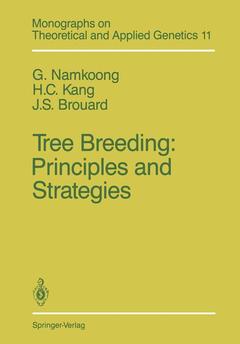Tree Breeding: Principles and Strategies, Softcover reprint of the original 1st ed. 1988 Principles and Strategies Monographs on Theoretical and Applied Genetics Series, Vol. 11
Langue : Anglais
Auteurs : Namkoong G., Kang H. C., Brouard J. S.

It has become apparent, during discussions with students and colleagues in forest genetics, that a universal concern is the achievement of diverse goals of forestry from fiber production in industrial as well as farm forests to conserving forest ecosystems. Although we generally have several breeding methods available and several species to breed, we seek to satisfy multiple-use goals on diverse sites by management techniques that at best can only partially control edaphic environmental variation. The dominant approach, which was agriculturally motivated, has involved inten sive effort with complicated breeding plans on single species for uniform adaptability and single-product plantations. However, this is obviously neither the only, nor necessarily the best, solution for the genetic management of tree species, and thus our intent in this volume is to develop ways to achieve multiple objectives in tree breeding. We include an array of breeding plans from simple iterated designs to sets of multiple populations capable of using gene actions for different traits in different environments for uncertain futures. The presentation is organized around the development of breeding from single-to multiple-option plans, from single to multiple traits, from single to mUltiple environ ments, and from single to multiple populations. However, it is not a complete "How To" book, and includes neither exercises nor instructions on data handling. It also does not include discussion of all modes of reproduction and inheritance encountered in plants.
1 Tree Breeding Opportunities and Limitations.- 1.1 Natural Selection.- 1.2 Gene Expression and Ecology in Selective Breeding.- 1.3 Relationship Between Natural and Artificial Selection.- 1.4 Conclusion.- 2 Defining Gene Effects.- 2.1 Models of Gene Action: One Locus.- 2.2 Models of Gene Action: Multiple Loci.- 2.3 Nonrandom Models.- 2.4 One-Locus Selection Models.- 2.5 Two-Locus Models.- 2.6 n-Locus Models.- 2.7 Selection, Inbreeding: Migration, Mutation, Population Size.- 2.8 Nonrandom Mating and Selection.- 3 Basic Concepts in Recurrent Selection.- 3.1 Changing Roles of Tree Breeding and Forest Genetics.- 3.2 Basic Model and Some Simple Models of Recurrent Selection.- 3.3 Gain and Limits to Selection.- 3.4 Developing Recurrent Selection Programs.- 3.5 Vegetative Propagation.- 4 General Recurrent Selection Systems.- 4.1 Mating Designs in Single-Population Breeding.- 4.2 Reciprocal Recurrent Selection for Hybrid Breeding.- 4.3 Multiple-Population Breeding.- 5 Selection Techniques.- 5.1 Heritability.- 5.2 Expected Gain from Direct Selection.- 5.3 Indirect Selection.- 5.4 Multitrait Selection Techniques.- 5.5 General Strategies for Multiple Breeding Objectives.- 5.6 Combining Gene Actions, Breeding Objectives, and Breeding Techniques.- 6 Environments.- 6.1 Genetic, Environmental, and Phenotypic Expression.- 6.2 Patterns of Response to Environmental Variation.- 6.3 Changes in Environments and Genotypes.- 6.4 Competition.- 7 Coping with Present and Future Breeding Problems.- 7.1 Coping with Inherent Breeding Problems.- 7.2 Strategies for Variable Ecological and Economic Environments.- 7.3 Multiple-Species Strategies.- 8 Provenance Testing, Ecogeographic Surveys, and Conservation.- 8.1 Species/Population Introduction and Testing.- 8.2 Provenance Trials.- 8.3 Provenance Testing and Ecogeographic Surveys.- 8.4 Genetic Resource Conservation.- References.
Date de parution : 02-2012
Ouvrage de 180 p.
17x24.4 cm
Mots-clés :
Conservation; complexity; ecology; environment; forest; tree
© 2024 LAVOISIER S.A.S.



